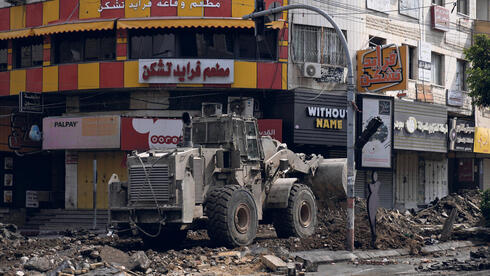
West Bank on the brink: economic woes spark fears of Intifada
Security forces brace for increased violence in the West Bank, driven by widespread unemployment and economic collapse in the Palestinian Authority.
The security establishment estimates that Judea and Samaria are on the brink of a new intifada, fueled by an economic crisis in the Palestinian Authority (PA) that has worsened since the war against Hamas in Gaza began in October 2023. This uprising could result in a severe and prolonged wave of attacks, requiring security forces to divert significant resources from the ongoing conflict in Gaza and the campaign against Hezbollah in the north. Early signs of unrest are already evident, as the IDF and Shin Bet have been conducting large-scale operations in West Bank cities and refugee camps, while thwarting dozens of terrorist attacks each week.
A key factor in the PA's economic downturn is the Israeli Cabinet's decision to prevent Palestinians from working in Israel after October 7. Approximately 120,000 Palestinians were employed in Israel before this, with most working in construction and agriculture. According to the Population and Immigration Authority, around 83,000 Palestinians were employed in construction, and 12,000 in agriculture. The cessation of this labor has had a massive impact on both the Palestinian and Israeli economies, as well as on security in Judea and Samaria.
A 2023 Bank of Israel report, published in March, outlined that halting Palestinian employment caused particularly serious damage to the agricultural sector, where the majority of workers were Palestinians or foreign nationals, and the construction industry, where Palestinians made up around a third of all workers, primarily performing "wet work." The report also criticized the Israeli government's efforts, which included encouraging Israeli labor, promoting industrialization and mechanization in construction, and bringing in additional foreign workers, as largely ineffective. It concluded that there is "no large-scale solution to the labor shortage in construction and agriculture other than the Palestinian workers, whose entry is currently not approved by the government." Today, only about 8,000 Palestinian workers are employed in Israel, with another 12,000 in settlements across Judea and Samaria.
The absence of Palestinian workers has also inflicted significant damage on the Israeli economy, costing billions of shekels. The shortage of workers is slowing the pace of construction, affecting the real estate industry and housing prices. Additionally, the labor gap has impacted national infrastructure projects, such as the construction of light rail networks in Jerusalem and Tel Aviv. Some construction companies have even admitted to employing illegal residents to cope with the labor shortage.
In February, two senior researchers at the Institute for National Security Studies (INSS), Lt. Col. (res.) Yohanan Tzoreff and Professor Esteban Klor, published a report titled "Returning Palestinian Workers from the West Bank to Work in Israel." The researchers warned that the PA's economy is in danger of collapse due to the ban on Palestinian workers entering Israel, resulting in 40% unemployment since the war (though more recent data suggest about 33% unemployment). Tzoreff and Klor noted that income from work in Israel and West Bank settlements accounted for around 20% of Palestinian GDP, with these workers contributing over $4 billion to the Palestinian economy in 2022, while the PA’s total annual budget stood at $6 billion.
The INSS study highlighted that Palestinian construction workers in Israel were earning around NIS 300 per day before the war, more than double the median wage of workers in the West Bank, which was around NIS 115 per day. The data in the study align with a World Bank report from May 2023, which presented similar figures and noted a 20% decrease in consumption in the last quarter of 2023 due to the loss of household income. The report also noted a 20% drop in Palestinian exports, with Israel being the primary export market for the PA.
Unemployment soared, the level of consumption plunged
Another metric of the Palestinian economic collapse is the sharp drop in tax revenues for the PA, which are transferred monthly by Israel as part of the Paris Agreement. These "settlement funds" include tax refunds on Palestinian labor and goods movement, with Israel deducting the PA’s debts, such as those owed to Israeli utility companies. Calcalist learned that before the war, the PA received monthly transfers of NIS 700-900 million, but since the conflict began, this amount has been reduced to NIS 300-400 million due to plummeting consumption in the Palestinian economy and rising unemployment.
The decrease in tax revenues has forced the PA to drastically cut its budget, significantly affecting the salaries of its employees, including 32,000 members of the PA’s security forces. This reduction in income has weakened the Palestinian security forces, which collaborate with Israeli forces to thwart terrorist attacks. A security source warned that as the PA security forces lose strength, "those with the money" — extremist groups — will gain influence.
Compounding the economic vacuum in the PA is the influence of Iran, Hamas, and Palestinian Islamic Jihad, which are pouring millions of shekels into the West Bank through cash or digital money transfers, including the use of cryptocurrencies. These funds fuel terrorist activities by incentivizing young Palestinians to carry out attacks in exchange for large sums of money. This has led to the rise of "freelance terrorists" who conduct operations for multiple groups, such as Hamas or Jihad, depending on who offers the highest payment for an attack.
The restrictions on Palestinian labor in Israel have also led to a thriving black market for illegal work. An estimated 30,000 to 40,000 illegal Palestinian residents are currently working in Israel, replacing legal workers and increasing security risks due to the lack of proper background checks or security screenings for these unauthorized laborers.














